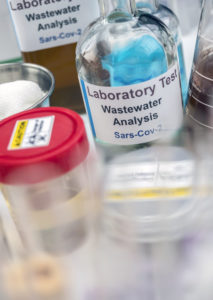There has been much chatter in the industry and wider media about the use of sewage epidemiology in the ongoing tracking of COVID-19 levels. How does this method work and how can it help in the fight against this pandemic?
Introduction to Sewage Epidemiology
Wastewater-based epidemiology (WBE) is used to measure a variety of trace substances in effluent for the purposes of public health monitoring. Indeed, the sampling of wastewater to track disease spread is not a new concept and is commonly used to measure levels of enteric viruses such as hepatitis, rotaviruses and noroviruses. Legal and illegal drug use is also monitored through traces found in local effluent sources. The SCORE network (Sewage analysis CORe group Europe) is a co-ordinated project to enable European researchers to compare the use of different illicit drugs across Europe by calculating the estimated milligrams consumed per 1000 people through analysis of their waste. You can view the results of this study in this interactive online resource.

How does Sewage Epidemiology work?
If a virus “sheds” in faeces, then theoretically it can be sampled within wastewater, typically through monitoring levels of its DNA or RNA (the genetic code of the virus). Techniques of measuring virus genetic code levels in wastewater typically fall into either quantitative polymerase chain reaction PCR (qPCR) or quantitative polymerase chain reaction PCR (qRT-PCR) approaches. Small trace amounts of DNA/RNA are amplified or elongated through highly calculated processes in order to give a reliable estimate of their equivalent real-life prevalence. For a full and detailed explanation of these scientific methods visit this page from Enzo. With SARS-CoV-2, although the RNA within faecal matter is no longer infectious, its concentration level in effluent still acts as a reliable guide to outbreak levels within the local population. With very few UK wastewater treatment works, each serving multiple cities and towns, a sample as small as a litre can give information on a vast number of people at one time.
Why is the development of Sewage Epidemiology important now?
Resistance to antibiotics, an increasing population and climate change are all contributing to an increased risk of new and mutated pathogenic organisms. Simply looking at the last two decades and the emergence of novel viruses such as SARS, MERS and Ebola shows the devastation that unrecognised viruses can bring to human existence. Being able to quickly monitor and act on the spread of these diseases is seen as critical in managing their risk to society. Intensive and costly monitoring systems such as track and trace are not always viable on a large scale due to virus infection and transmission rates. A community-level measurement method of disease levels, such as WBE, can act as an effective early warning system for infectious disease outbreaks and support more individual-level testing such as track and trace. Sampling local wastewater sources can provide comprehensive and real-time information on levels of disease in a local area, indicating when an outbreak is likely before it has even happened.
How is it being used in the fight against COVID-19?
Our current UK testing programme focuses on those already showing symptoms, meaning that asymptomatic carriers are typically not included in disease prevalence or growth estimates. With a high number of COVID-19 carriers known to be asymptomatic, the risk is that prevalence is critically underestimated when relying solely on individual testing and we could enter a second wave of exponential growth before even realising the threat.
Wastewater sampling plugs this gap through its ability to accurately gauge the threat of local or national outbreaks before they have occurred by monitoring the viral shed of both symptomatic and asymptomatic COVID-19 carriers through their faecal excretion. Typically the virus appears in faeces much earlier (3 days after infection)* than appearance of the symptoms that we are being asked to identify, such as a cough or high temperature. The sampling time can take as little 48 hours, quickly giving local authorities and government data to be able to take swift decisions in locking down or releasing specific areas.
Governments have been quick to understand and react to the potential of sewage monitoring for this critical purpose and have funded various accelerated research projects and live trials across the world. In the UK there are many trials taking place with local water authorities, government, leading universities, Defra, the Environment Agency, the Natural Environment Research Centre, the Engineering and Physical Sciences Research Council and UK Research & Innovation all partnering to progress a range of projects. A number of live trials are already taking place with local water authorities as of June 2020, with the data gathered feeding directly into the government’s COVID-19 Alert System.
Further Resources
As a supplier of wastewater sampling and flow measurement systems we have been closely following this industry development in the fight against COVID-19. Some resources that we have found particularly helpful/interesting are as follows if you would like to understand more around this topic. If you would like to speak to us about your own wastewater sampling requirements, we are continuing to provide our services during the pandemic. Please contact us for more information.
https://newatlas.com/science/science-sewage-wastewater-based-epidemiology/
https://www.ncbi.nlm.nih.gov/pmc/articles/PMC7128895/
https://www.emcdda.europa.eu/topics/pods/waste-water-analysis#panel2
https://www.sciencedirect.com/science/article/pii/S0160412010002515